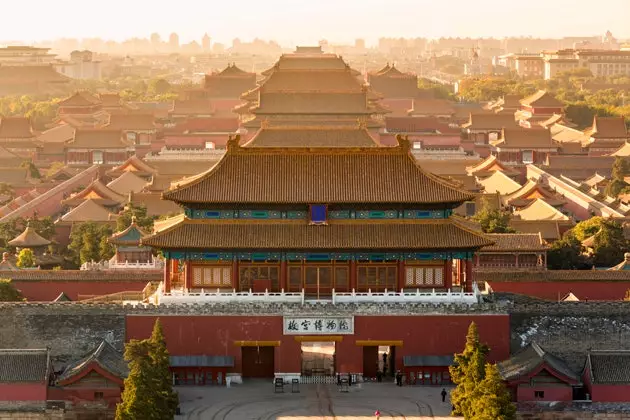
The sky over Beijing
1. THE PROHIBITED CITY
At the dawn of the empire, the early Chinese believed that the earth was square and that the country was the center of that world, with a square earth and above, of course, the sky hovered as a great circle. So, what less than to build a palace comparable to such an honor . Some first constructions, including the mythical 'casoplón' of Kublai Khan -Of which there are still some traces in the Behai Park -, gave way to the largest palace complex on the planet, the prohibited city.
The Ming dynasty spared no expense and honor, just like the Qing later did : stone carved to the filigree, multicolored woods and precious metals in the form of mythical animals populated the rectangular map of this microcosm, whose orientation in a perfect calculation places it in line with some of the most brilliant stars in the sky.
It was here where shapes and numbers began to make sense and there is a whole protocol . Wherever you look, everything is nines or the multiplication of them; the statues that crown the roofs, the wall of the dragons, the steps that lead to the pavilions or the tacks on the doors, even the rooms, which add up to a whopping 9,999. Here everything is huge and majestic.
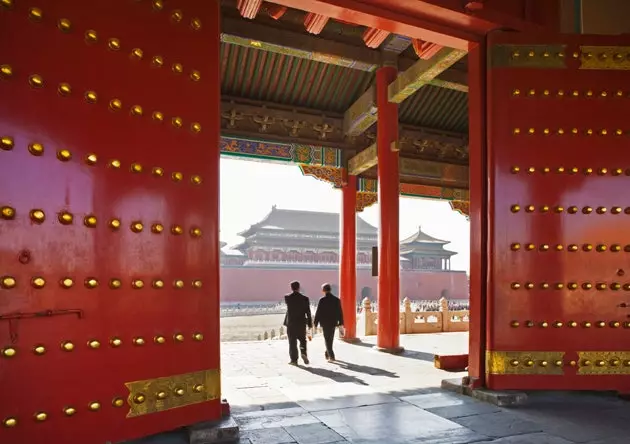
The great gate of the Forbidden City
Arm yourself with patience to see the interior of the pavilions, in a fight with hundreds of tourists and photo cameras . Don't get lost in the tide and drop by the clock museum, the five bridges that cross the inner river, the rooms with the treasures of the forbidden city or the stone gardens.
Once outside go up to the call Coal Hill, jinshan park , from where you will have the Forbidden City at your feet, in a panorama that, according to a legend, was the one that the last Ming emperor saw before hanging himself on a tree while the city fell into the hands of his enemies, the future and last dynasty of the Qing. Precisely, and due to twists and turns of fate, the last of the Qing, Puyi, also had to leave the Forbidden City by force. His eventful life is portrayed with absolute mastery by Bernardo Bertolucci in one of the greatest films in the history of cinema, The last Emperor.
two. TIAN'ANMEN SQUARE
This was where on October 1, 1949 Mao Tse Tung announced from the Gate of Heavenly Peace the proclamation of the People's Republic of China, years of civil war and a future led by and for the people was predicted. In its day it was the largest square in the world, with its 440,000 square meters. Modern times have taken that honor away from him to bestow it, and only for the moment, on his compatriot Xinghai Square, in the city of Dalian. Still, in our hearts and in the eyes of Mao, whose face will always watch over his subjects from Tian'anmen Gate, he will continue to bear that title.
You have to walk through it with your eyes open, fundamentally so as not to bump into anyone and, above all, so as not to miss the hustle and bustle that meets there every day. Military parades and Chinese tourists from all corners of the country hang around the very Soviet monuments to the people's revolution. If you want to greet Mao or the silken mummy they say they take out from time to time to protect the authentic one, gets up very early, because the fervor of the thousands of Chinese who arrive in the capital every day with the sole objective of see the leader They make queues last forever.
If you have time, take a walk at sunset , when kite fliers congregate in the square, harnessing the wind to lift their rice-paper creatures into the Beijing sky.
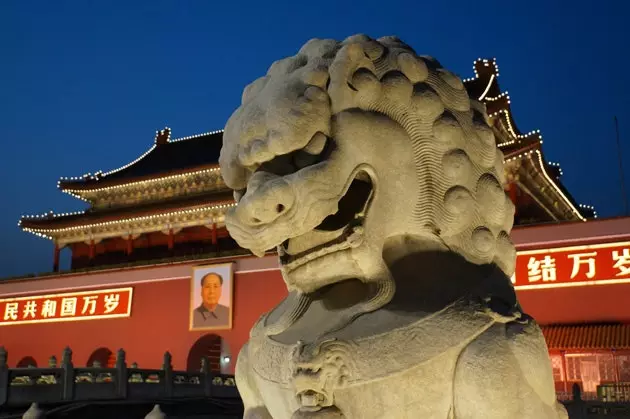
Tian'Anmen Square
3. HUTONG HERE, HUTONG THERE
They are a disappearing asset, the Beijing urban planning commission quantified them at 3,000 in 1949, today there are less than 1,300 who still survive . The new urban plans are converting the hutongs into costumbristas decorated for extreme capitalism, with the same stores that you can find in your nearest shopping center, however, and although we are not going to deny that those who have already gone through the facelift They look like new are those who still resist the onslaught of time those who tell us about a past full of stories with their own names.
Low, with interior patio and brick , conquered by bicycles and always in the shade of a hundred-year-old tree, the hutongs are to Beijing what the neighborhoods of all life are to our cities. These alleys, whose name was transmitted orally until well into the 20th century, are where you should come to see what the Beijingers do and imitate them: haggle in their small shops, eat at their traditional food stalls, smile at everyone and throw bike to go around them.
In addition, in them you will find some of the most charming accommodation in the city, in old houses of bureaucrats and merchants converted into boutique hotels. Cours Et Pavillons and Ruyuan Courtyard, both in the district of Dongcheng are just some of them.
It was the chores of the merchants who lived in each of them that gave them their names, such as the rice hutong, the scissors hutong or the tea leaves hutong. Don't miss Qianshi Alley or money, where the first banks of the capital proliferated, or the outskirts of Liulichang Lu , the street of artists, where writers and painters for six hundred years have gone to buy rice paper, brushes and colored inks for their creations.
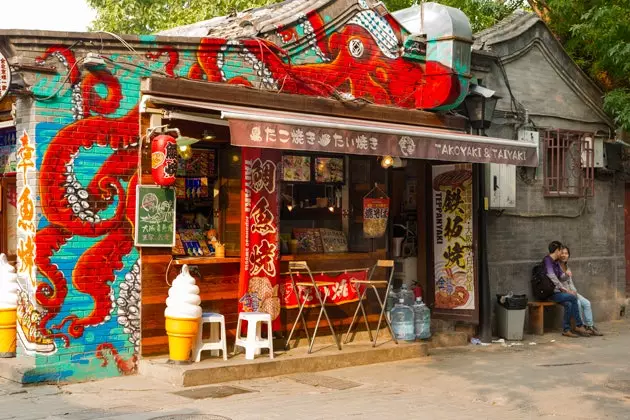
Hutong, disappearing neighborhoods...
Four. CHINESE RESTAURANTS
As the capital of a great empire, Beijing settled citizens from all over the country, who brought with them the specialties of their home province. Thus, its gastronomy is varied, going through the sweet flavors of the coastal provinces until the spicy from Hunan and Sichuan provinces , not to mention the dumplings and their delicious vegetarian cuisine.
More the king of kitchens is the lacquered duck. Its preparation is not at all simple, with different cooking processes, the simplest thing is to eat it together with some very fine flour pancakes and an oyster sauce. Try the one slowly browned at Shangri-La-branded Kerry Hotel restaurant The Horizon, or the one savored by Barack Obama during his visits to Beijing at the restaurant of the country's most celebrated Chinese chef, Da Dong.
All the kids in town know the names of the back lakes by heart: Xi Hai, Hou Hai and Qian Hai, and that today make up a single crescent-shaped mass of water. In winter, when its surface freezes over, Beijingers come here to skate on the ice, to later have lunch or dinner at one of the many restaurants that surround them, one of the specialties of the city, the hot-pot . In summer, the hot pot gives way to the terraces that overlook the lakes on summer nights and to the specialties based on fish and shellfish.
Our advice is to have the names of some basic foods written down, such as chicken or beef in Chinese characters, since not all restaurants have a menu in English and with photographs.
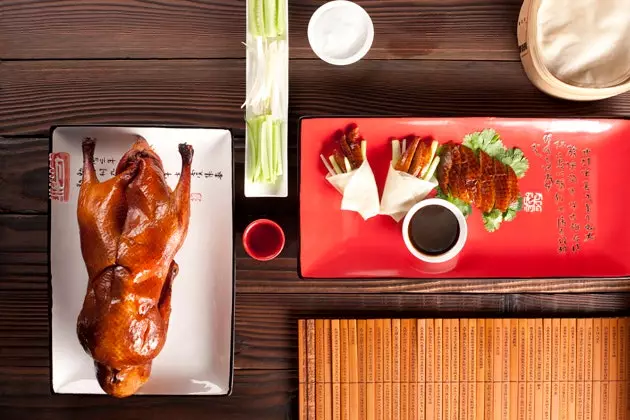
The art of the lacquered duck
5. AWAY FROM THE NOISE OF THE WORLD
With the arrival of the extreme summer heat of Beijing, the emperor and his entire court moved to the Summer Palace to spend, logically, the summer. A set of pavilions and gardens that must have been idyllic before the arrival of tourism, however, if you are lucky you can reach experience a certain calm if the holidays of the Chinese working calendar are avoided. Architecturally speaking, it is a curious and worth seeing complex, where eclecticism is rampant, with Tibetan temples, a pavilion made entirely of bronze or a corridor of 728 meters long raised in wood and fully decorated with paintings on its entire surface.
During the Opium Wars , and later after the Boxer Rebellion, Western forces that entered the capital circled here, laying waste to everything in their path, including Attila's horses. It is said that the Empress Cixi she ordered to rebuild everything at the expense of the budgets to update the navy. Of course, a ship was built, although it cannot sail since it is completely made of marble, from bow to stern. It is located on the shore of Kunming Lake, which was artificially excavated to resemble the Hangzhou City West Lake . With the sand they raised the hill of Longevity, as far as it can be reached by steep and endless stairs. It is said that whoever completes the ascent will have a very long life.
Lose yourself in its gardens and pavilions , and when you get tired of walking, get on one of the boats that ply the lake and let it take you back to the starting square.
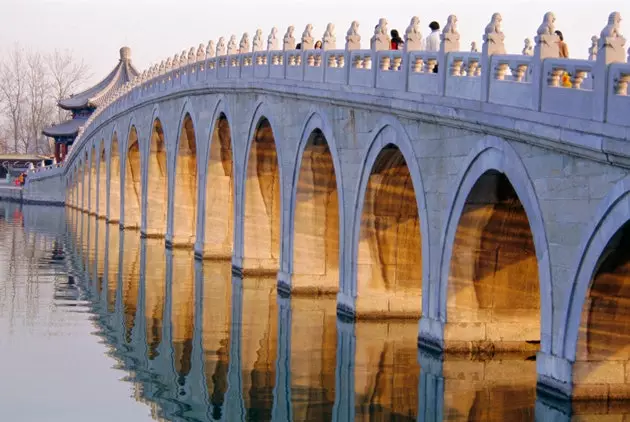
The Seventeen Arch Bridge of the Summer Palace
6. ART INDUSTRY
An old industrial zone, full of brick buildings built in 1953 in the Bauhaus style and with an urban framework worthy of Tetris, it is home to Chinese contemporary art. Is he Dashanzi art district , better known as the district 798 . Here the most cutting-edge galleries in the country proliferate like mushrooms, with the best in sculpture, painting and video art. Perhaps it is one of the few places where you can see Chinese art in its purest form, that is, without any censorship.
Just by wandering the streets, colors and shapes speak of a new China willing to break artistic molds . The best plan is to go from gallery to gallery, aimlessly, and make the occasional purchase, until you feel hungry. By then you will have seen so many restaurants and cafes between gallery and gallery, that it will not be difficult for you to choose one of them for dinner. You can even stay the night, because the hoteliers are not stupid and have planted a hotel inside the complex, the Beijing Yi-House 798 Art Hotel, where, of course, contemporary art is one of its charms.
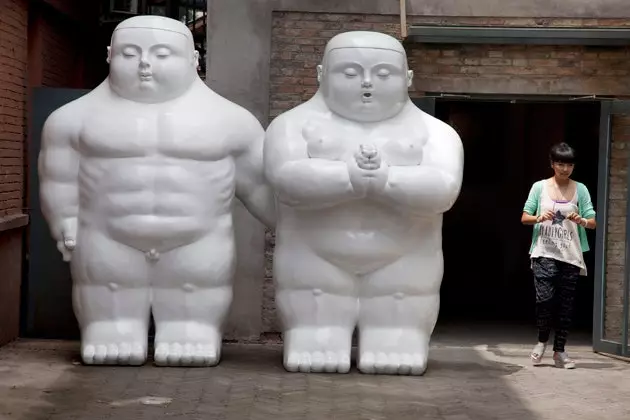
District 798, Beijing art without limits
7. THE SKY IS ROUND
Get up early if you want to see what is considered the most perfect building in Beijing, the Temple of Heaven. Just when the park that houses it opens its doors and the chirping of the birds still surrounds everything and its only passers-by have come to do Tai Chi, it is the perfect moment to spot China's most famous circular structure . Hundreds of cobalt blue tiles cover in three circumferences what was once the hall of prayer for good harvests.
Once a year, in one of the few and exceptional departures from it, the son of heaven traveled to this complex to ask for a year rich in cereals. Secondary temples served as preparatory rooms for the great ceremony, whose high point was lived in the circular altar, made up of three circular floors of white marble that converge in a single round piece, where the offerings were made. Today there is no visitor who does not want to take a selfie on it to predict a good year.
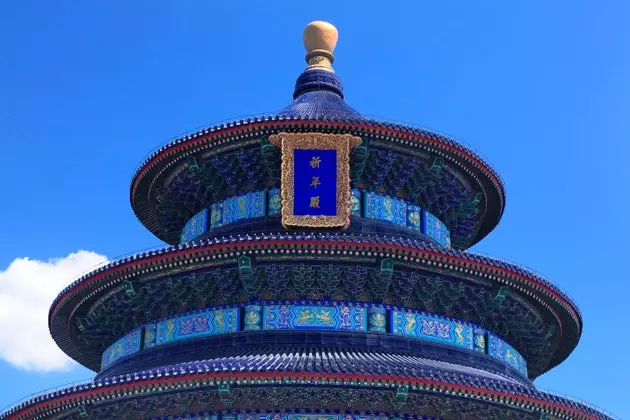
The temple of the good harvest
8. RENEWED SPIRITUALITY
Traditional religions, which were almost forgotten during the cultural revolution, are making a strong comeback in China. the lamaism It is one of the ones that is gaining more strength among the Chinese. The Lama Temple is pure earthly spirituality, it could be said that it is a small piece of Tibet in Beijing. A succession of patios and wooden buildings painted with a thousand colors and very long names anticipate the final climax, a 26 meter tall Buddha statue , located in a pavilion with the same visual impact. They say it was made from a single block of sandalwood. Enjoy its narrow alleys and the artistic roofs of the pavilions.
Here everything is incense, prayers and huge amounts of yuan burned, submerged or simply deposited in dozens of giant cauldrons scattered throughout the complex. A mix that has to be seen to be believed. Be lazy when the monks start to close the temple , take a breath and experience the magic of the place without tourists.
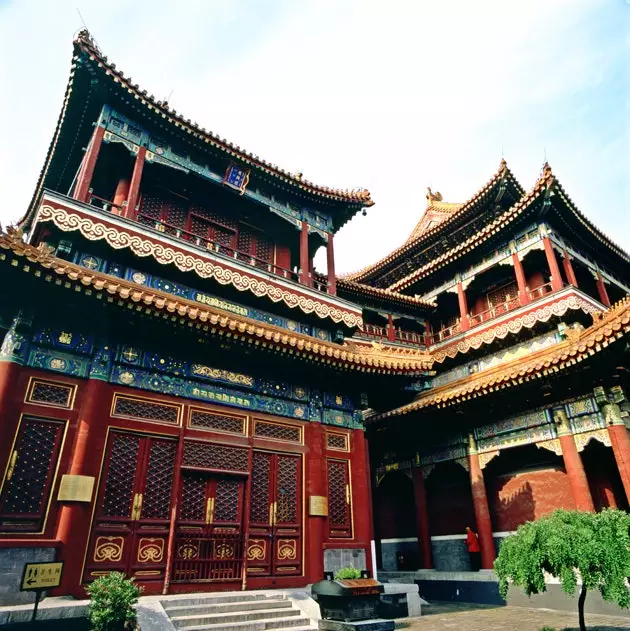
Pekingese Lamanism
9. PANJIAYUAN, BARGAINING WITH MEMORIES
Shopping heaven is the Panjiayuan flea market. Under a huge tent, this craft market reaches its splendor every Sunday. Sculptures, jade, porcelain and even all kinds of vestiges of Mao's cultural revolution, which are authentic antiques and others that try to sneak you in as such. It is a small chaos, in which if you want something you will have to fight until exhaustion in a war without quarter to reach the best price. The key is to enjoy, for them it has a lot to play , and in paying what you think that object of desire that you want to take home is worth. rest assured that they will always win so take it easy.
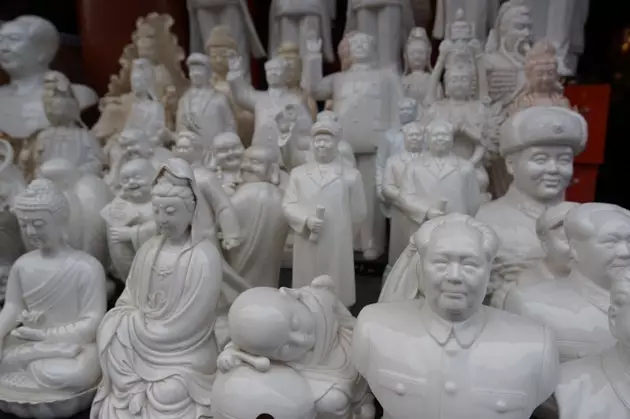
The paradise of shopping is the Panjiayuan flea market
*SQUARING THE CIRCLE
Because Beijing wouldn't be the same without her. , and since it is true that it is not technically on the city map, the Great Wall of China it's ours bonus track on this perfect journey.
It is colossal and embraces the ancient borders of the Empire in a hug, like a gigantic snake that guards and watches the movements of the enemy. Conceived over more than a thousand years and with hundreds of kilometers and landscapes, visiting it is the goal of many travelers. There are different sections to fulfill the dream. The very touristy and sweetened Badaling, the less crowded Mutianyu, with unrestored sections where you can get lost like an explorer. This one also has a small slide where you can go down at the end of the visit, the one chosen by Beyonce. And the very wild Jinshanling and Simatai, above all because of their state of conservation, with almost unrestored sections, and because of the impressive and rugged landscape that welcomes them and where trekking is an adventure for the most intrepid.
And although it is very widespread, it is not true that the wall can be seen from space. What does happen in reverse, from it you can see the sky. The sky over Beijing.
Follow @alvaroanglada
_ You may also be interested..._*
- 100 things about China you should know
- 10 authentic Chinese dishes (and three delights are not rolls or rice)
- 20 things to do in Beijing at least once in your life
- The best Chinese restaurants in Madrid (according to a Chinese woman)
- All articles by Álvaro Anglada
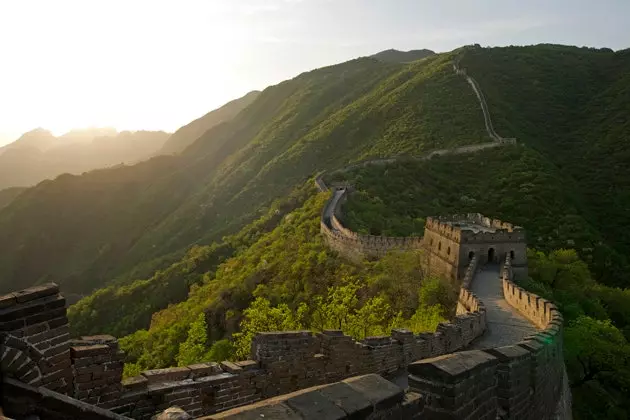
The perfect bonus track: the Great Wall of China
